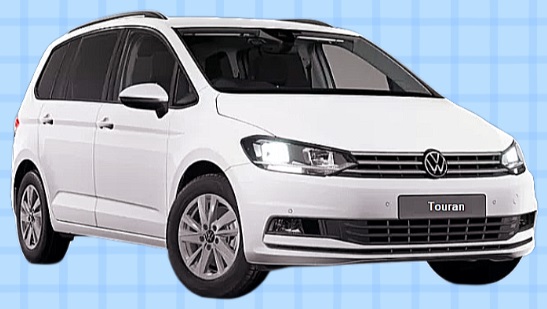Volkswagen Touran costs, pros, cons and common fixes

Country of Manufacture
The Volkswagen Golf Touran is built in Wolfsburg, Germany, on the MQB evo platform.
Quick Overview
The Touran is a compact seven-seat MPV with a dynamic profile, balanced proportions, and a twin-slat grille. Its modular cabin features sliding and folding seats, a configurable 10.25″ Digital Cockpit, a 10″ infotainment touchscreen, tri-zone climate control, and premium materials throughout.
Powertrain & Performance
| Engine | Power & Torque | 0–100 km/h | Top Speed | WLTP Consumption |
|---|
| 1.5 TSI eTSI MHEV (110 kW / 150 hp) | 150 hp / 250 Nm | 8.9 s | 220 km/h | 5.2–5.6 L/100 km |
| 2.0 TDI (85 kW / 115 hp) | 115 hp / 300 Nm | 11.5 s | 200 km/h | 4.3–4.7 L/100 km |
| 2.0 TDI (110 kW / 150 hp) | 150 hp / 360 Nm | 9.0 s | 220 km/h | 4.6–5.0 L/100 km |
All engines are available with a 6-speed manual or 7-speed DSG dual-clutch gearbox.
Dimensions & Capacity
| Specification | Measurement |
|---|
| Length | 4,527 mm |
| Width | 1,829 mm (excl. mirrors) |
| Height | 1,657 mm |
| Wheelbase | 2,791 mm |
| Curb Weight | 1,445–1,650 kg |
| Cargo Volume | 693 L / 1,920 L |
| Ground Clearance | 165 mm |
| Turning Circle | 11.2 m |
Trim Levels & Pricing
| Trim | Price (€) |
|---|
| Life | 33,900 |
| Style | 35,900 |
| R-Line | 37,900 |
(On-the-road price; VAT included, incentives and delivery fees excluded.)
Maintenance & First Services (Indicative Costs)
| Service | Average Cost (€) |
|---|
| 1st Service (1 yr or 15,000 km) | 220–260 |
| 2nd Service (2 yrs or 30,000 km) | 240–280 |
| Front Brake Pads Replacement | 220–260 |
| Front Discs + Pads Replacement | 600–700 |
| Cabin & Engine Air Filter Replacement | 120–150 |
| 12 V Auxiliary Battery Replacement | 150–180 |
| Tire Replacement (each) | 160–200 |
Pros
Spacious & Versatile: accommodates seven seats and 1,920 L of cargo with all rear seats folded
Modular Interior: sliding and folding second-row seats for configurable layouts
Advanced Tech: configurable Digital Cockpit, touchscreen infotainment, and modern ADAS
Comfort: tri-zone climate control and suspension tuned for long journeys
Efficiency: mild-hybrid and diesel engines deliver strong economy
Cons
Bulky Footprint: larger dimensions can challenge urban parking
Less Sporting: styling and ride focus more on comfort than sportiness
Weight: heavier curb weight affects agility and consumption in mixed driving
Optional Costs: DSG transmission and comfort packs increase the final price
In Summary
The Volkswagen Golf Touran 2025 remains the go-to compact MPV for families seeking space, flexibility, and advanced technology. It delivers a comfortable, modular interior and efficient powertrains—while trading off some urban agility and commanding a higher price in fully equipped form.
Verdict — Volkswagen Golf Touran (Model Year 2025)
Compact Mild-Hybrid MPV · 1.5 L TSI 4-cyl 150 hp + 48 V Mild-Hybrid · FWD · 6-spd Manual or 7-spd DSG · 0–100 km/h in 9.2 s · WLTP 5.4–6.0 L/100 km · 123–136 g/km CO₂ · 150 mm Ground Clearance
The 2025 Golf Touran redefines the compact family MPV with modern styling and functional proportions (4.52 m length, 2.78 m wheelbase). Its updated front end mirrors the Golf hatch—Matrix LED headlights, honeycomb grille, and flush door handles—while the elongated side profile and expansive glasshouse ensure light and visibility. 17″ “Riom” wheels strike a balance between comfort and efficiency.
Inside, the “Family Flex” cabin emphasizes modularity and connectivity: a horizontal soft-touch dash hosts a 10.25″ digital driver display and a 10″ central touchscreen for infotainment and tri-zone climate control. Seven SmartFold seats (2+3+2) fold individually to tailor passenger and cargo needs. A low-load-floor boot offers 639 L with all seats up and expands to 2,053 L with seats down. Wireless Apple CarPlay/Android Auto, over-the-air updates, and VW’s Travel Assist suite complete the package.
| Category | Strengths | Performs Well | Limitations |
|---|
| Design & Styling | Clean, family-friendly MPV silhouette; Matrix LEDs | Understated, timeless look | Less dynamic than some crossover alternatives |
| Comfort & Packaging | Seven-seat flexibility; SmartFold modular seating | Generous headroom and legroom front/rear | Center tunnel intrudes on middle-row foot space |
| Efficiency & Economy | Mild-hybrid enhances urban efficiency | Smooth regenerative braking | No pure-electric driving mode |
| Driving Dynamics | Precise steering; stable handling | Well-balanced between comfort and control | Ride can feel firm on very rough surfaces |
| Practicality | 639 L boot (+2,053 L folded); low load sill | Numerous clever storage cubbies | No front trunk (“frunk”) |
| Infotainment & Connect. | 10″ touchscreen; 10.25″ Digital Cockpit; OTA updates | Wireless CarPlay/Android Auto; intuitive UI | Built-in navigation requires optional upgrade |
| Safety & ADAS | Travel Assist & Emergency Assist standard | Effective adaptive cruise and lane-keep assist | No fully hands-free highway driving |
| Running Costs | Low routine maintenance; mild-hybrid incentives | Reduced fuel use in city | Mild-hybrid service network still growing |
| Depreciation | Strong residuals in the MPV segment | Consistent used-car demand | Competition from SUVs and electric MPVs |
Who It’s For
Families and those needing versatile seven-seat transport with generous cargo space, efficient mild-hybrid performance, and advanced connectivity—ideal for daily drives and long journeys.
Who Should Look Elsewhere
If you require full EV power or all-wheel drive, consider the Škoda Octavia Combi 4×4, Hyundai Ioniq 6 Touring, or Mercedes-Benz EQE Estate.
Recommended Configuration
Style 7 trim with SmartFold seating, tri-zone Climatronic, Comfort & Lighting pack (heated seats, head-up display), Travel Assist Plus, and 18″ “Sierra” wheels—for maximum flexibility, comfort, and safety.
![]() Volkswagen Touran costs, pros, cons and common fixes
Volkswagen Touran costs, pros, cons and common fixes 

